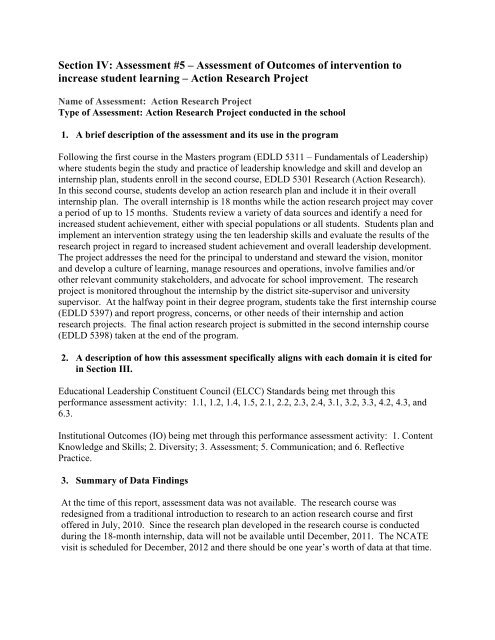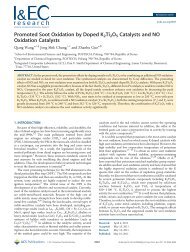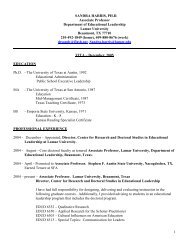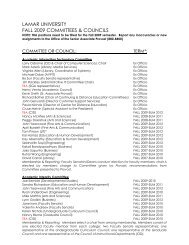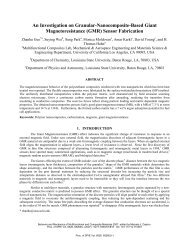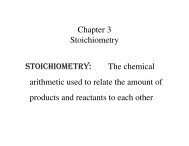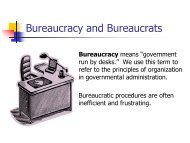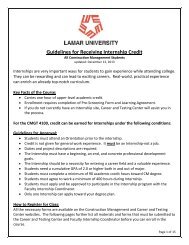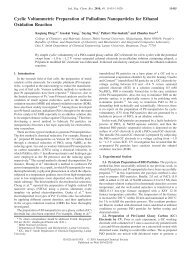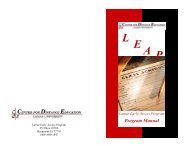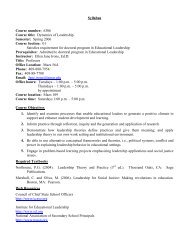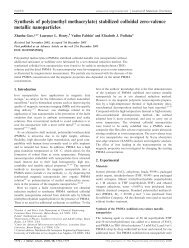Action Research Project - Lamar University
Action Research Project - Lamar University
Action Research Project - Lamar University
Create successful ePaper yourself
Turn your PDF publications into a flip-book with our unique Google optimized e-Paper software.
Section IV: Assessment #5 – Assessment of Outcomes of intervention to<br />
increase student learning – <strong>Action</strong> <strong>Research</strong> <strong>Project</strong><br />
Name of Assessment: <strong>Action</strong> <strong>Research</strong> <strong>Project</strong><br />
Type of Assessment: <strong>Action</strong> <strong>Research</strong> <strong>Project</strong> conducted in the school<br />
1. A brief description of the assessment and its use in the program<br />
Following the first course in the Masters program (EDLD 5311 – Fundamentals of Leadership)<br />
where students begin the study and practice of leadership knowledge and skill and develop an<br />
internship plan, students enroll in the second course, EDLD 5301 <strong>Research</strong> (<strong>Action</strong> <strong>Research</strong>).<br />
In this second course, students develop an action research plan and include it in their overall<br />
internship plan. The overall internship is 18 months while the action research project may cover<br />
a period of up to 15 months. Students review a variety of data sources and identify a need for<br />
increased student achievement, either with special populations or all students. Students plan and<br />
implement an intervention strategy using the ten leadership skills and evaluate the results of the<br />
research project in regard to increased student achievement and overall leadership development.<br />
The project addresses the need for the principal to understand and steward the vision, monitor<br />
and develop a culture of learning, manage resources and operations, involve families and/or<br />
other relevant community stakeholders, and advocate for school improvement. The research<br />
project is monitored throughout the internship by the district site-supervisor and university<br />
supervisor. At the halfway point in their degree program, students take the first internship course<br />
(EDLD 5397) and report progress, concerns, or other needs of their internship and action<br />
research projects. The final action research project is submitted in the second internship course<br />
(EDLD 5398) taken at the end of the program.<br />
2. A description of how this assessment specifically aligns with each domain it is cited for<br />
in Section III.<br />
Educational Leadership Constituent Council (ELCC) Standards being met through this<br />
performance assessment activity: 1.1, 1.2, 1.4, 1.5, 2.1, 2.2, 2.3, 2.4, 3.1, 3.2, 3.3, 4.2, 4.3, and<br />
6.3.<br />
Institutional Outcomes (IO) being met through this performance assessment activity: 1. Content<br />
Knowledge and Skills; 2. Diversity; 3. Assessment; 5. Communication; and 6. Reflective<br />
Practice.<br />
3. Summary of Data Findings<br />
At the time of this report, assessment data was not available. The research course was<br />
redesigned from a traditional introduction to research to an action research course and first<br />
offered in July, 2010. Since the research plan developed in the research course is conducted<br />
during the 18-month internship, data will not be available until December, 2011. The NCATE<br />
visit is scheduled for December, 2012 and there should be one year’s worth of data at that time.
4. An interpretation of how that data provides evidence for meeting each domain it is<br />
cited for in Section III.<br />
At the time of this report, assessment data was not available. See assignment tools in attachment<br />
5a and the scoring rubric in attachment 5b.<br />
5. Attachments<br />
Section IV: Assessment #5 Attachment 5a (Assessment Tool)<br />
Section IV: Assessment #5 Attachment 5b (Scoring Rubric)
Attachment 5a - Section IV / Assessment #5 Assessment Tool<br />
Objective: The intern will use a variety of data sources to identify a learning or school<br />
culture/learning environment need, engage school staff and community in addressing this need,<br />
and plan and implement an intervention and measure the impact of the intervention with the goal<br />
of improving student achievement or improving school culture/learning environment.<br />
Premise: The principal is ultimately responsible for assuring that high expectations for student<br />
achievement occur for all students. The principal is expected to work collaboratively with a<br />
variety of diverse stakeholders to engage them in a shared vision for high student achievement<br />
and to facilitate the work required for the teaching and learning process. Additionally,<br />
understanding the larger context of the district and community is essential for a principal to align<br />
the work of the school with district initiatives, strategic plan and budget, and to keep his/her<br />
stakeholders informed and involved in decision making.<br />
Performance Requirements: The intern will assess the needs of the school with supportive<br />
data and choose an action research project approved by the site-supervisor that can and will be<br />
used in the school. The chosen research project (intervention) must serve the purpose of<br />
increasing student achievement and/or improving the school culture/learning environment. The<br />
intervention should be long-term in nature but may be shorter, if multiple interventions are<br />
planned and implemented. The intern is expected to begin his/her action research project<br />
following approval of the plan developed in the second course, EDLD 5301 <strong>Research</strong>. The<br />
project will become a major part of the overall internship plan and will be completed at the<br />
beginning of the last course, EDLD 5398 Internship. The intern is expected to make adequate<br />
progress (approximately half of the project completed) by the 7 th course, EDLD 5397 Internship<br />
for Supervision.<br />
<strong>Action</strong> <strong>Research</strong> <strong>Project</strong> Requirements, Part 1<br />
Activity #1 - Title<br />
Provide a clear, brief title that describes your <strong>Action</strong> <strong>Research</strong> <strong>Project</strong>. The title should describe<br />
what you are trying to find out, not what you think you will find.<br />
Activity #2 – Needs Assessment<br />
Indicate how the need for an improvement was determined. Note the data collected to support<br />
the<br />
need. Present the data in a disaggregated manner in terms of ethnicity, gender, etc.<br />
Activity #3 – Objectives and Vision of the Intervention (ELCC 1.1)<br />
After completing the needs assessment, develop a vision relating to the improvement needed and<br />
develop an intervention that includes measureable objectives in terms of expected results.<br />
Activity #4 – Review of the Literature and Intervention Strategy - Apply Best Practice to<br />
Student Learning (ELCC 2.3)<br />
Review recent literature related to the topic of your research project. The research should<br />
support why<br />
your intervention plan would be described as a best practice or possible solution to improving<br />
achievement or culture. The review of the literature should be written in APA style with a<br />
reference<br />
page listing the sources. Explain the decision making process for implementing the<br />
intervention. Who<br />
was involved? What was considered? What decisions were made?
Activity #5 – Articulate the Vision (ELCC 1.2)<br />
Describe how you communicated the vision of the intervention to staff, parents, students, and<br />
community members.<br />
Activity #6 – Manage the Organization (ELCC 3.1)<br />
Describe the strategy used for organizing the implementation of the project noting<br />
responsibilities given<br />
to self and others and how you managed any monies, time, materials, and people. Give examples<br />
of<br />
how you put a priority on student learning and safety.<br />
Activity #7 – Manage Operations (ELCC 3.2)<br />
Describe the strategy used to lead the operations of the project and set priorities. Include a brief<br />
description of how you used the needs assessment, data, group process skills, built consensus,<br />
communicated, and resolved conflict.<br />
Activity #8 – Respond to Community Interest and Needs (ELCC 4.2)<br />
Describe how the intervention (research project) will serve the needs of students with special and<br />
exceptional needs and students with diverse backgrounds (cultural, ethnic, economic, or special<br />
interest groups). Elaborate on methods used to address any specific needs of the school or<br />
community.<br />
Activity #9 – Implement the Vision (ELCC 1.3)<br />
Describe in detail how the intervention was implemented. This can be in table format noting<br />
who, what, when, where, and how, with an emphasis on results. Include timelines and deadlines<br />
of benchmarks to be accomplished. Note the involvement of faculty and community.<br />
Activity #10 – Steward the Vision (ELCC 1.4)<br />
In reference to the table in the above #9, describe the process used to build a shard commitment<br />
to the intervention. Include motivation techniques used with staff, students, and families to<br />
achieve the vision of the intervention. Include effective communication skills and strategies used<br />
to monitor, evaluate, and revise the intervention.<br />
Activity #11 – Promote Community Involvement in the Vision (ELCC 1.5)<br />
Describe methods used to collaborate with community members in the development and<br />
implementation of the vision promoted by the intervention.<br />
Activity #12 – Manage Resources (ELCC 3.3)<br />
Describe how you managed in an effective, efficient, and equitable manner the use of fiscal<br />
and/or human resources to support the intervention. Include any of the following skills that<br />
apply (or others): problem-solving skills, strategic planning skills, and/or technology skills.<br />
Activity #13 – Mobilize Community Resources (ELCC 4.3)<br />
Indicate how community resources were used to support the vision of the intervention, e.g., use<br />
of youth services, school resources, social service agencies, new resources in the community,<br />
and/or public resources or funds.
Activity #14 – Promote Positive School Culture (ELCC 2.1)<br />
Using the results from the “Results/Conclusions” section below, explain how the intervention<br />
promoted a positive school culture of school improvement to meet the needs of all students.<br />
Activity #15 – Provide an Effective Instructional Program (ELCC 2.2) – Results and<br />
Conclusions<br />
Conduct a satisfaction or feedback survey to all stakeholders impacted by the intervention.<br />
Compare the results of the initial needs assessment and the ending survey in measuring increased<br />
student achievement or improvement to the school culture/learning environment. If multiple<br />
objectives were planned for, evaluate and analyze each one. Display the results in a clear and<br />
concise format, e.g., table, lists, sections, etc. Using the resulting data, provide conclusions and<br />
recommendations for modifications or changes in the school.<br />
Activity #16 – Influencing the Larger Context (ELCC 6.3)<br />
Describe your plan for disseminating the results and recommendations of the action research<br />
project. Note influential persons or groups that you believe would assist in advocating for your<br />
proposed recommendations.<br />
Activity #17 – Design a Comprehensive Professional Growth Plan (ELCC 2.4)<br />
Using the Results/Recommendations section, outline professional growth strategies needed to<br />
enable the faculty to successfully realize the vision of your intervention.<br />
<strong>Action</strong> <strong>Research</strong> <strong>Project</strong> Requirements, Part 2<br />
Reflect on the overall action research project in terms of content knowledge and skills, diversity,<br />
technology, communication, and reflective practice using the following reflective questions:<br />
What have I learned from conducting this action research project?<br />
How has this experience increased my general leadership competence?<br />
What would I do differently in conducting an action research project in the future?<br />
How did this project make a difference in the school?<br />
What does the evaluation data (survey) suggest for future projects to solve school problems?<br />
In considering the ten leadership skills, which ones do you believe are now strengths and which<br />
ones need additional study and practice?<br />
<strong>Action</strong> <strong>Research</strong> Plan Template<br />
Abstract<br />
This is a ½ to 1 page executive review of the entire proposal - basically, an overall summary.<br />
Introduction<br />
This is typically a couple of paragraphs describing the overall scenario or context of your study,<br />
e.g. name of school, location, relevant history, demographics (ethnicity and socio-economic level
of students, grade levels, urban or rural, etc.), your position, and any other relevant information<br />
that will assist the reader in understanding the context of your study. Include any significant<br />
challenges or biases discovered that might impact the study.<br />
Section One – Nature of the Problem<br />
Statement of the problem<br />
This is typically a brief paragraph describing the problem or issue you are confronting, in general<br />
terms.<br />
Purpose of the Study<br />
This is typically a brief paragraph stating what you will research or what you want to find out.<br />
This may be in the form of a research question or simply a statement describing your purpose.<br />
Significance of the Study<br />
This paragraph explains who will benefit from the information that your action research project<br />
will provide, and how, or in what ways they will benefit. Be sure to add a sentence noting that<br />
your study will add to the knowledge base of your topic (e.g. middle school discipline, peer<br />
tutoring, etc.)<br />
Definition of Terms<br />
This will be a listing of terms that you believe need to be defined so that readers outside of your<br />
school or field can better understand. Education seems to have its own language.<br />
Section Two – Literature Review<br />
This may be several pages or many pages that explain what the current research shows about<br />
your topic. You will cite research from articles, studies, etc., including district information<br />
gathered to this point pertinent to your study. You do not need to scour all the research but try to<br />
find quality articles from experts in the field. There is no limit on the number of references cited<br />
but typically, 6-8 studies will suffice. The answer to how many or how long this section should<br />
be is stopping whenever you feel you have a good grasp of what the literature shows about your<br />
topic.<br />
Section Three – <strong>Action</strong> <strong>Research</strong> Design<br />
Subjects<br />
Describe your target population and if you are using a sample, how did you select your sample<br />
and the rationale for your sample size.<br />
Procedures<br />
Describe the actions (in research terms, this is the intervention) you plan to take to address the<br />
problem you are trying to solve. Include a proposed timeline of when you plan to begin and the<br />
expected completion date. If you are planning on actions that utilize steps of a longer process,<br />
include proposed timelines for each step. Also include resources needed and persons<br />
responsible, if others are involved in your action plan.<br />
Data Collection<br />
Describe the methods you propose to use to collect data. For example, this could be collecting<br />
data from observations, journals, surveys, interviews, homework, tests, office referrals, etc. Be<br />
sure to accurately describe the method. For example, if you plan to use a survey, will it be for
the entire group or individually; will it be a pre and post survey; or will it be a checklist or essay.<br />
Give enough information that the reader fully understands what and how you will collect the<br />
data.<br />
Section Four – Proposed Analysis of the Data<br />
Describe the method you propose to use to analyze the collected data. For example, you may<br />
propose to compare percentages of passing scores on an assignment with scores from a similar<br />
previous assignment, numbers of office referrals over the length of the study to determine<br />
increasing or decreasing trends, or you may want to use more formal analysis and statistics, if<br />
you deem appropriate. Include how you propose to present the date, e.g., tables, bar graphs,<br />
narrative, etc.<br />
Section Five – Proposed Evaluation<br />
Evaluating the Results of the Study<br />
Describe how you plan to evaluate the results of your actions in the study. This could be<br />
changes in student learning (from grades, tests, observations, etc), changes in student behavior<br />
(class disruptions, office referrals, detention hall, etc.), changes in climate (morale, motivation,<br />
self-esteem, etc.), or changes in costs (amount of savings to the school, etc.). It is recommended<br />
that you use formative evaluations periodically during your action research project. If you do,<br />
include timelines for each evaluation.<br />
Dissemination of the Results of the Study<br />
Explain how you plan to share the findings of your research. Keep in mind that many other<br />
teachers and administrators in your school / district and in other schools and districts may benefit<br />
greatly from your study. Also keep in mind that you have an option of publishing your study<br />
online. (More information will be given on this later)<br />
Appendix A<br />
Leadership Plan<br />
As part of your internship or practicum, you will be the leader in developing, implementing,<br />
monitoring, and evaluating your action research project. List proposed leadership actions in each<br />
of the 12 areas.<br />
Specific actions you propose to do in order to:<br />
1) Build trusting relationships<br />
2) Create a shared vision<br />
3) Collaborate on decisions<br />
4) Communicate effectively<br />
5) Lead productive groups<br />
6) Resolve issues or conflicts<br />
7) Motivate others<br />
8) Manage a positive culture and climate<br />
9) Use appropriate leadership style<br />
10) Empower others<br />
11) Manage change<br />
12) Evaluate self and overall study
Attachment 5b - Section IV / Assessment #5 Scoring Guide<br />
Tasks<br />
Accomplished<br />
Proficient<br />
Needs<br />
Improvement<br />
1<br />
Unacceptable<br />
3<br />
2<br />
0<br />
EDLD 5301/5398 <strong>Action</strong> <strong>Research</strong> Plan and <strong>Project</strong><br />
Cutoff Score: 2.0 and above “meets expectations”; 1.0 and below “does not meet expectations.”<br />
ELCC Standard 1.1<br />
Develop a Vision<br />
The vision of<br />
learning was very<br />
clear, based on<br />
relevant knowledge<br />
and promoted the<br />
success of all<br />
students in terms of<br />
diversity and learner<br />
needs.<br />
(ELCC 1.1a,b)<br />
The vision of<br />
learning was based<br />
on relevant<br />
knowledge and<br />
promoted the<br />
success of most<br />
students in terms of<br />
diversity and learner<br />
needs.<br />
(ELCC 1.1a,b)<br />
The vision of learning<br />
was somewhat clear,<br />
based on relevant<br />
knowledge and<br />
somewhat promoted<br />
the success of all<br />
students in terms of<br />
diversity and learner<br />
needs.<br />
(ELCC 1.1a,b)<br />
The vision of<br />
learning was not<br />
clear, was vague<br />
regarding relevant<br />
knowledge and did<br />
not promote the<br />
success of all<br />
students in terms of<br />
diversity and learner<br />
needs.<br />
(ELCC 1.1a,b)<br />
ELCC Standard 1.2<br />
Articulate a Vision<br />
The candidate very<br />
clearly<br />
communicated the<br />
components of the<br />
vision of learning<br />
to the staff,<br />
students, and<br />
community with<br />
many quality<br />
leadership<br />
processes from the<br />
following, i.e., use<br />
of symbols,<br />
ceremonies,<br />
stories, student<br />
assessments,<br />
demographic data,<br />
community needs,<br />
strategic planning<br />
processes, databased<br />
research<br />
The candidate<br />
communicated the<br />
components of the<br />
vision of learning<br />
to the staff,<br />
students, and<br />
community with an<br />
adequate amount<br />
of quality<br />
leadership<br />
processes from the<br />
following, i.e,, use<br />
of symbols,<br />
ceremonies,<br />
stories, student<br />
assessments,<br />
demographic data,<br />
community needs,<br />
strategic planning<br />
processes, databased<br />
research<br />
The candidate<br />
somewhat<br />
communicated the<br />
components of the<br />
vision of learning to<br />
the staff, students,<br />
and community with<br />
some quality<br />
leadership<br />
processes from the<br />
following, i.e,, use of<br />
symbols,<br />
ceremonies, stories,<br />
student<br />
assessments,<br />
demographic data,<br />
community needs,<br />
strategic planning<br />
processes, databased<br />
research<br />
strategies.<br />
The candidate did<br />
not clearly<br />
communicate the<br />
components of the<br />
vision of learning<br />
to the staff,<br />
students, and<br />
community and<br />
used limited quality<br />
leadership<br />
processes from the<br />
following, i.e,, use<br />
of symbols,<br />
ceremonies,<br />
stories, student<br />
assessments,<br />
demographic data,<br />
community needs,<br />
strategic planning<br />
processes, databased<br />
research
strategies.<br />
(ELCC 1.2a,b)<br />
strategies.<br />
(ELCC 1.2a,b)<br />
(ELCC 1.2a,b)<br />
strategies.<br />
(ELCC 1.2a,b)<br />
ELCC Standard 1.3<br />
Implement a Vision<br />
The candidate very<br />
clearly developed<br />
plans and many<br />
processes for<br />
implementing the<br />
vision from the<br />
following, i.e.,<br />
articulated the<br />
vision, used<br />
collaboration,<br />
encouraged<br />
challenging<br />
standards, used<br />
student<br />
assessments,<br />
structured<br />
significant work,<br />
motivated all<br />
constituents,<br />
delegated<br />
responsibilities,<br />
supported<br />
innovation, caused<br />
others to lead, and<br />
procured<br />
necessary<br />
resources.<br />
(ELCC 1.3a,b)<br />
The candidate<br />
developed plans<br />
and an adequate<br />
amount of<br />
processes for<br />
implementing the<br />
vision from the<br />
following, i.e.,<br />
articulated the<br />
vision, used<br />
collaboration,<br />
encouraged<br />
challenging<br />
standards, used<br />
student<br />
assessments,<br />
structured<br />
significant work,<br />
motivated all<br />
constituents,<br />
delegated<br />
responsibilities,<br />
supported<br />
innovation, caused<br />
others to lead, and<br />
procured<br />
necessary<br />
resources.<br />
ELCC 1.3a,b)<br />
The candidate<br />
somewhat<br />
developed plans<br />
and some<br />
processes for<br />
implementing the<br />
vision from the<br />
following, i.e.,<br />
articulated the<br />
vision, used<br />
collaboration,<br />
encouraged<br />
challenging<br />
standards, used<br />
student<br />
assessments,<br />
structured<br />
significant work,<br />
motivated all<br />
constituents,<br />
delegated<br />
responsibilities,<br />
supported<br />
innovation, caused<br />
others to lead, and<br />
procured necessary<br />
resources.<br />
ELCC 1.3a,b)<br />
The candidate did<br />
not develop clear<br />
plans and used<br />
limited processes<br />
for implementing<br />
the vision from the<br />
following, i.e.,<br />
articulated the<br />
vision, used<br />
collaboration,<br />
encouraged<br />
challenging<br />
standards, used<br />
student<br />
assessments,<br />
structured<br />
significant work,<br />
motivated all<br />
constituents,<br />
delegated<br />
responsibilities,<br />
supported<br />
innovation, caused<br />
others to lead, and<br />
procured<br />
necessary<br />
resources.<br />
ELCC 1.3a,b)<br />
ELCC Standard 1.4<br />
Steward a Vision<br />
The candidate very<br />
clearly guided the<br />
building of a<br />
shared<br />
commitment to the<br />
vision with many<br />
various methods<br />
from the following,<br />
i.e., effective<br />
communication<br />
skills, data-based<br />
research strategies<br />
to monitor,<br />
The candidate<br />
guided the building<br />
of a shared<br />
commitment to the<br />
vision with an<br />
adequate number<br />
of various methods<br />
from the following,<br />
i.e., effective<br />
communication<br />
skills, data-based<br />
research strategies<br />
to monitor,<br />
The candidate<br />
somewhat guided<br />
the building of a<br />
shared commitment<br />
to the vision with<br />
some methods from<br />
the following, i.e.,<br />
effective<br />
communication<br />
skills, data-based<br />
research strategies<br />
to monitor, evaluate,<br />
and revise the<br />
The candidate did<br />
not clearly guide<br />
the building of a<br />
shared<br />
commitment to the<br />
vision and used<br />
limited methods<br />
from the following,<br />
i.e., effective<br />
communication<br />
skills, data-based<br />
research strategies<br />
to monitor,
evaluate, and<br />
revise the vision.<br />
(ELCC 1.4a,b)<br />
evaluate, and<br />
revise the vision.<br />
(ELCC 1.4a,b)<br />
vision.<br />
(ELCC 1.4a,b)<br />
evaluate, and<br />
revise the vision.<br />
(ELCC 1.4a,b)<br />
ELCC Standard 1.5<br />
Promote<br />
Community<br />
Involvement in<br />
the Vision<br />
The candidate very<br />
clearly<br />
demonstrated the<br />
ability to effectively<br />
communicate with<br />
and involve all<br />
appropriate staff<br />
and community<br />
members in the<br />
realization and<br />
implementation of<br />
the vision and in<br />
related school<br />
improvement<br />
efforts.<br />
The candidate<br />
demonstrated the<br />
ability to effectively<br />
communicate with<br />
and involve most<br />
of the appropriate<br />
staff and<br />
community<br />
members in the<br />
realization and<br />
implementation of<br />
the vision and in<br />
related school<br />
improvement<br />
efforts.<br />
The candidate<br />
somewhat<br />
demonstrated the<br />
ability to effectively<br />
communicate with<br />
and involve some of<br />
the appropriate staff<br />
and community<br />
members in the<br />
realization and<br />
implementation of<br />
the vision and in<br />
related school<br />
improvement efforts.<br />
The candidate<br />
demonstrated a<br />
limited ability to<br />
effectively<br />
communicate with<br />
and involve<br />
appropriate staff<br />
and community<br />
members in the<br />
realization and<br />
implementation of<br />
the vision and in<br />
related school<br />
improvement<br />
efforts.<br />
ELCC Standard 2.1<br />
Promote Positive<br />
School Culture<br />
The candidate was<br />
very clearly able to<br />
delineate how<br />
multiple methods<br />
were used to<br />
assess the<br />
intervention<br />
strategy’s impact<br />
on school culture<br />
and school<br />
programs for<br />
diversity with many<br />
examples from the<br />
following, i.e.,<br />
population, race,<br />
language, gender<br />
disability, socioeconomic,<br />
etc.<br />
(ELCC 2.1a)<br />
The candidate was<br />
able to delineate<br />
how multiple<br />
methods were<br />
used to assess the<br />
intervention<br />
strategy’s impact<br />
on school culture<br />
and school<br />
programs for<br />
diversity with an<br />
adequate number<br />
of examples from<br />
the following, i.e.,<br />
population, race,<br />
language, gender<br />
disability, socioeconomic,<br />
etc.<br />
(ELCC 2.1a)<br />
The candidate was<br />
somewhat able to<br />
delineate how<br />
multiple methods<br />
were used to assess<br />
the intervention<br />
strategy’s impact on<br />
school culture and<br />
school programs for<br />
diversity with some<br />
examples from the<br />
following, i.e.,<br />
population, race,<br />
language, gender<br />
disability, socioeconomic,<br />
etc.<br />
(ELCC 2.1a)<br />
The candidate<br />
demonstrated a<br />
limited ability to<br />
delineate how<br />
multiple methods<br />
were used to<br />
assess the<br />
intervention<br />
strategy’s impact<br />
on school culture<br />
and school<br />
programs for<br />
diversity with<br />
limited examples<br />
from the following,<br />
i.e., population,<br />
race, language,<br />
gender disability,<br />
socio-economic,<br />
etc.<br />
(ELCC 2.1a)<br />
ELCC Standard 3.1<br />
Manage the<br />
Organization<br />
The candidate was<br />
very clearly able to<br />
develop excellent<br />
plans of action for<br />
The candidate was<br />
able to develop<br />
plans of action for<br />
focusing on<br />
The candidate was<br />
somewhat able to<br />
develop plans of<br />
action for focusing<br />
The candidate<br />
developed in a<br />
limited manner,<br />
plans of action for
focusing on<br />
effective<br />
organizational<br />
development and<br />
effective<br />
management of<br />
fiscal, time,<br />
human, and<br />
material resources,<br />
giving priority to<br />
student learning,<br />
safety, curriculum,<br />
and instruction.<br />
Appropriate<br />
principles of<br />
organizational<br />
development and<br />
data driven<br />
decision-making<br />
with attention to<br />
indicators of<br />
equity,<br />
effectiveness, and<br />
efficiency were<br />
very clearly<br />
demonstrated.<br />
(ELCC 3.1a,b,c)<br />
effective<br />
organizational<br />
development and<br />
effective<br />
management of<br />
fiscal, time,<br />
human, and<br />
material resources,<br />
giving priority to<br />
student learning,<br />
safety, curriculum,<br />
and instruction.<br />
Appropriate<br />
principles of<br />
organizational<br />
development and<br />
data driven<br />
decision-making<br />
with attention to<br />
indicators of<br />
equity,<br />
effectiveness, and<br />
efficiency were<br />
demonstrated.<br />
(ELCC 3.1a,b,c)<br />
on effective<br />
organizational<br />
development and<br />
effective<br />
management of<br />
fiscal, time, human,<br />
and material<br />
resources, giving<br />
priority to student<br />
learning, safety,<br />
curriculum, and<br />
instruction.<br />
Appropriate<br />
principles of<br />
organizational<br />
development and<br />
data driven<br />
decision-making<br />
with attention to<br />
indicators of equity,<br />
effectiveness, and<br />
efficiency were<br />
somewhat<br />
demonstrated.<br />
(ELCC 3.1a,b,c)<br />
focusing on<br />
effective<br />
organizational<br />
development and<br />
effective<br />
management of<br />
fiscal, time,<br />
human, and<br />
material resources,<br />
giving priority to<br />
student learning,<br />
safety, curriculum,<br />
and instruction.<br />
The candidate<br />
described in a<br />
limited manner<br />
appropriate<br />
principles of<br />
organizational<br />
development and<br />
data driven<br />
decision-making<br />
with attention to<br />
indicators of<br />
equity, efficiency<br />
and effectiveness.<br />
(ELCC 3.1a,b,c)<br />
ELCC Standard 3.2<br />
Manage<br />
Operations<br />
The candidate very<br />
clearly<br />
demonstrated in<br />
detail the ability to<br />
involve staff in<br />
conducting<br />
operations and<br />
setting priorities<br />
using appropriate<br />
needs<br />
assessment,<br />
research-based<br />
data, and group<br />
process skills to<br />
build consensus,<br />
communicate,<br />
involve community<br />
collaboration, and<br />
The candidate was<br />
able to<br />
demonstrate the<br />
ability to involve<br />
staff in<br />
conducting<br />
operations and<br />
setting priorities<br />
using appropriate<br />
needs<br />
assessment,<br />
research-based<br />
data, and group<br />
process skills to<br />
build consensus,<br />
communicate,<br />
involve community<br />
collaboration, and<br />
The candidate was<br />
somewhat able to<br />
demonstrate the<br />
ability to involve<br />
staff in<br />
conducting<br />
operations and<br />
setting priorities<br />
using appropriate<br />
needs assessment,<br />
research-based<br />
data, and group<br />
process skills to<br />
build consensus,<br />
communicate,<br />
involve community<br />
collaboration, and<br />
resolve conflicts in<br />
The candidate was<br />
not able to<br />
demonstrate the<br />
ability to involve<br />
staff in<br />
conducting<br />
operations and<br />
setting priorities<br />
using appropriate<br />
needs<br />
assessment,<br />
research-based<br />
data, and group<br />
process skills to<br />
build consensus,<br />
communicate,<br />
involve community<br />
collaboration, and
esolve conflicts in<br />
order to align<br />
resources with the<br />
vision and provide<br />
for educational<br />
equity and a safe<br />
and effective<br />
facility.<br />
(ELCC 3.2a,b,c)<br />
resolve conflicts in<br />
order to align<br />
resources with the<br />
vision and provide<br />
for educational<br />
equity and a safe<br />
and effective<br />
facility.<br />
(ELCC 3.2a,b,c)<br />
order to align<br />
resources with the<br />
vision and provide<br />
for educational<br />
equity and a safe<br />
and effective facility.<br />
(ELCC 3.2a,b,c)<br />
resolve conflicts in<br />
order to align<br />
resources with the<br />
vision and provide<br />
for educational<br />
equity and a safe<br />
and effective<br />
facility.<br />
(ELCC 3.2a,b,c)<br />
ELCC Standard 3.3<br />
Manage<br />
Resources<br />
The candidate was<br />
able to clearly<br />
demonstrate in<br />
detail the use of<br />
many problemsolving<br />
skills,<br />
strategic planning<br />
skills, technology<br />
skills, and<br />
operational<br />
planning<br />
techniques in the<br />
effective, legal,<br />
and equitable use<br />
of fiscal, human,<br />
and material<br />
resource allocation<br />
and alignment that<br />
focused on<br />
teaching and<br />
learning, and<br />
business<br />
procedures.<br />
(ELCC3.3a,b,c)<br />
The candidate was<br />
able to<br />
demonstrate the<br />
adequate use of<br />
problem-solving<br />
skills, strategic<br />
planning skills,<br />
technology skills,<br />
and operational<br />
planning<br />
techniques in the<br />
effective, legal,<br />
and equitable use<br />
of fiscal, human,<br />
and material<br />
resource allocation<br />
and alignment that<br />
focused on<br />
teaching and<br />
learning, and<br />
business<br />
procedures.<br />
(ELCC3.3a,b,c)<br />
The candidate was<br />
able to use some<br />
problem-solving<br />
skills, strategic<br />
planning skills,<br />
technology skills,<br />
and operational<br />
planning techniques<br />
in the effective,<br />
legal, and equitable<br />
use of fiscal,<br />
human, and material<br />
resource allocation<br />
and alignment that<br />
focused on teaching<br />
and learning, and<br />
business<br />
procedures.<br />
(ELCC3.3a,b,c)<br />
The candidate<br />
demonstrated a<br />
limited use of<br />
problem-solving<br />
skills, strategic<br />
planning skills,<br />
technology skills,<br />
and operational<br />
planning<br />
techniques in the<br />
effective, legal,<br />
and equitable use<br />
of fiscal, human,<br />
and material<br />
resource allocation<br />
and alignment that<br />
focused on<br />
teaching and<br />
learning, and<br />
business<br />
procedures.<br />
(ELCC3.3a,b,c)<br />
ELCC Standard 4.2<br />
Respond to<br />
Community<br />
Interests and<br />
Needs<br />
The candidate was<br />
clearly able to<br />
demonstrate active<br />
involvement within<br />
the community,<br />
including<br />
interactions with<br />
individuals with<br />
conflicting views,<br />
by using<br />
assessment<br />
The candidate was<br />
able to<br />
demonstrate active<br />
involvement within<br />
the community,<br />
including<br />
interactions with<br />
individuals with<br />
conflicting views,<br />
by using<br />
assessment<br />
The candidate was<br />
somewhat able to<br />
demonstrate active<br />
involvement within<br />
the community,<br />
including<br />
interactions with<br />
individuals with<br />
conflicting views, by<br />
using assessment<br />
strategies and<br />
The candidate was<br />
not able to clearly<br />
demonstrate active<br />
involvement within<br />
the community,<br />
including<br />
interactions with<br />
individuals with<br />
conflicting views,<br />
by using<br />
assessment
strategies and<br />
research methods<br />
to accommodate<br />
all of the diverse<br />
school and<br />
community<br />
conditions, serving<br />
many students<br />
with special and<br />
exceptional needs,<br />
and capitalizing on<br />
much of the<br />
diversity (cultural,<br />
ethnic, racial,<br />
economic, and<br />
special interest<br />
groups) in the<br />
school and<br />
community to<br />
improve school<br />
programs to meet<br />
the diverse<br />
learning needs.<br />
(ELCC 4.2a,b,c,d)<br />
strategies and<br />
research methods<br />
to accommodate<br />
an adequate<br />
amount of the<br />
diverse school and<br />
community<br />
conditions, serving<br />
an adequate<br />
number of<br />
students with<br />
special and<br />
exceptional needs,<br />
and capitalizing on<br />
an adequate<br />
amount of the<br />
diversity (cultural,<br />
ethnic, racial,<br />
economic, and<br />
special interest<br />
groups) in the<br />
school and<br />
community to<br />
improve school<br />
programs to meet<br />
the diverse<br />
learning needs.<br />
(ELCC 4.2a,b,c,d)<br />
research methods to<br />
accommodate some<br />
of the diverse<br />
school and<br />
community<br />
conditions, serving<br />
some of students<br />
with special and<br />
exceptional needs,<br />
and capitalizing on<br />
some of the<br />
diversity (cultural,<br />
ethnic, racial,<br />
economic, and<br />
special interest<br />
groups) in the<br />
school and<br />
community to<br />
improve school<br />
programs to meet<br />
the diverse learning<br />
needs of all<br />
students.<br />
(ELCC 4.2a,b,c,d)<br />
strategies and<br />
research methods<br />
to accommodate<br />
diverse school and<br />
community<br />
conditions, serving<br />
students with<br />
special and<br />
exceptional needs,<br />
and capitalizing on<br />
the diversity<br />
(cultural, ethnic,<br />
racial, economic,<br />
and special<br />
interest groups) in<br />
the school and<br />
community to<br />
improve school<br />
programs to meet<br />
the diverse<br />
learning needs of<br />
all students.<br />
(ELCC 4.2a,b,c,d)<br />
ELCC Standard 4.3<br />
Mobilize<br />
Community<br />
Resources<br />
The candidate was<br />
very clearly able to<br />
demonstrate an<br />
ability to use many<br />
community<br />
resources to<br />
support student<br />
achievement and<br />
support school<br />
goals with many of<br />
the following<br />
examples, i.e., use<br />
of youth services,<br />
school resources,<br />
social service<br />
agencies, new<br />
resources in the<br />
The candidate was<br />
able to<br />
demonstrate an<br />
ability to use<br />
adequate<br />
community<br />
resources to<br />
support student<br />
achievement and<br />
support school<br />
goals with an<br />
adequate amount<br />
of the following<br />
examples, i.e., use<br />
of youth services,<br />
school resources,<br />
social service<br />
The candidate was<br />
somewhat able to<br />
demonstrate an<br />
ability to use some<br />
community<br />
resources to support<br />
student<br />
achievement and<br />
support school<br />
goals with some of<br />
the following<br />
examples, i.e., use<br />
of youth services,<br />
school resources,<br />
social service<br />
agencies, new<br />
resources in the<br />
The candidate<br />
demonstrated a<br />
limited ability to<br />
use community<br />
resources to<br />
support student<br />
achievement and<br />
support school<br />
goals with a limited<br />
number of the<br />
following<br />
examples, i.e., use<br />
of youth services,<br />
school resources,<br />
social service<br />
agencies, new<br />
resources in the
community and<br />
public resources<br />
and funds.<br />
(ELCC 4.3a,b,c)<br />
agencies, new<br />
resources in the<br />
community and<br />
public resources<br />
and funds.<br />
(ELCC 4.3a,b,c)<br />
community and<br />
public resources<br />
and funds.<br />
(ELCC 4.3a,b,c)<br />
community and<br />
public resources<br />
and funds.<br />
(ELCC 4.3a,b,c)<br />
ELCC 6.3<br />
Influence the<br />
Larger Context<br />
The candidate<br />
was very clearly<br />
able to<br />
demonstrate a<br />
superior ability<br />
to engage<br />
students, parents,<br />
and other<br />
community<br />
members in<br />
advocating for<br />
improvements in<br />
schools and<br />
clearly<br />
demonstrated the<br />
application of<br />
knowledge of the<br />
larger social,<br />
political, and<br />
economic<br />
community<br />
environment.<br />
(ELCC 6.3a,b,c)<br />
The candidate<br />
was able to<br />
demonstrate the<br />
ability to engage<br />
students, parents,<br />
and other<br />
community<br />
members in<br />
advocating for<br />
improvements in<br />
schools and<br />
demonstrated the<br />
application of<br />
knowledge of the<br />
larger social,<br />
political, and<br />
economic<br />
community<br />
environment.<br />
(ELCC 6.3a,b,c)<br />
The candidate was<br />
somewhat able to<br />
demonstrate the<br />
ability to engage<br />
students, parents,<br />
and other<br />
community<br />
members in<br />
advocating for<br />
improvements in<br />
schools and<br />
somewhat<br />
demonstrated the<br />
application of<br />
knowledge of the<br />
larger social,<br />
political, and<br />
economic<br />
community<br />
environment.<br />
(ELCC 6.3a,b,c)<br />
The candidate<br />
was not able to<br />
demonstrate the<br />
ability to engage<br />
students, parents,<br />
and other<br />
community<br />
members in<br />
advocating for<br />
improvements in<br />
schools and did<br />
not demonstrate<br />
the application<br />
of knowledge of<br />
the larger social,<br />
political, and<br />
economic<br />
community<br />
environment.<br />
(ELCC 6.3a,b,c)<br />
APA Writing<br />
Exhibits graduate<br />
level writing and<br />
organization (APA<br />
format, no spelling<br />
or grammatical<br />
errors, citation of<br />
resources)<br />
Exhibits near<br />
graduate level<br />
writing and<br />
organization<br />
(pseudo-APA<br />
format, no spelling<br />
or grammatical<br />
errors, citation of<br />
resources)<br />
Exhibits near<br />
graduate level<br />
writing/organization<br />
(pseudo-APA<br />
format, no more<br />
than 3 spelling or<br />
grammatical errors,<br />
citation of most<br />
resources)<br />
Does not exhibit<br />
graduate level<br />
writing/<br />
organization<br />
(incorrect format,<br />
4 or more spelling<br />
or grammatical<br />
errors, noncitation<br />
of<br />
resources)


